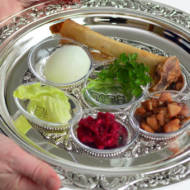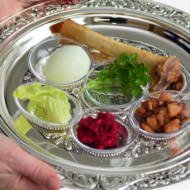
Let’s take a look at the Passover Seder plate, also known as the Ke’ara, to learn about which foods grace the plate and what they symbolize.
By Rabbi Ari Enkin, Rabbinic Director, United with Israel
The Seder plate contains six items, all related to the story of the Exodus from Egypt.
The six traditional items on the Seder Plate are:
Marror and Chazeret
The marror and chazeret, usually horseradish and romaine lettuce, though some use endives, symbolize the bitter life of slavery that the Jewish people endured for over 200 years in Egypt.
Bitter herbs are eaten at two different points in the seder. They are first eaten at the “Marror” station of the seder where they are consumed without dipping, and then again at the “Korech” station, where they are eaten as a sandwich in between two matzahs. Some people use the same bitter herb for both, while others use horseradish for one and romaine lettuce for the other. Indeed, some seder plates do not include a spot for “chazeret,” as “marror” and “chazeret” are essentially the same idea.
‘Charoset’
Charoset is not merely one of the symbolic foods of the Seder but it is also eaten on its own, sometimes as a dip for matza or even as a dessert. It is a sweet, brown mixture made from chopped nuts – usually walnuts – grated apples, cinnamon, and sweet red wine. There are other Charoset recipes as well.
The Charoset represents the mortar that the Jewish slaves used to build the buildings of Egypt. The marror is dipped into the charoset before it is eaten.
‘Karpas‘
Karpas is a vegetable that is eaten as an appetizer at the beginning of the Seder. It is dipped into salt water (some families use vinegar) to recall the bitter tears of slavery.
Some sources teach that the use of a vegetable also recalls that with Passover comes spring, when vegetation begins its regrowth. Most Ashkenazi families use celery or parsley for karpas, but many also use potatoes or radishes. Essentially any vegetable can be used for Karpas except for vegetables that qualify as “marror” above.
As all ritual meals in Judaism begin with a blessing on bread (or matza)h, beginning the meal by dipping a vegetable in salt water is also intended to invoke questions from the children. In fact, one of the “Four Questions” is why there is so much dipping on the Seder night!
Zero’a (Shank Bone)
The zero’a is a bone of some sort. Most people use a chicken neck or a shank bone. The zero’a recalls the beloved Passover lamb, the Passover sacrifice that was offered during Temple times in Jerusalem. Just like the Passover sacrifice was roasted, so too the zero’a bone should be roasted as well.
Beitzah (Egg)
The beitza is an egg which symbolizes a second, lesser-known, festival sacrifice that was offered in the Temple in addition to the Passover lamb. It was called the “Chagiga Sacrifice” and was an independent offering in honor of the holiday.
An egg is used to commemorate the chagigah sacrifice in order to recall the destruction of the Temple. Since the Jewish people are known as “mourners for Zion,” an egg is used as it is the primary mourner’s food in Judaism. Furthermore, the fast day of Tisha B’av, which commemorates the destruction of Jerusalem, always falls out on the same day of the week as the Passover Seder. For these reasons, widespread custom is to begin the festive Seder meal by eating an egg in salt water.
Send Passover Food Packages to Needy Israeli Soldiers
We are honored to thank the young men and women of the IDF who risk their lives to protect the citizens of Israel. Join us in sending Passover food packages (and personal notes) to needy Israeli soldiers and their families.
Bring Passover joy and blessing to the heroes of Israel who defend our freedom every day!
Many soldiers spend the Passover holiday with needy families back home. The soldiers greatly appreciate your love and concern.
CLICK HERE TO SEND YOUR PACKAGE AND NOTE TO ISRAELI SOLDIERS!
Source: United with Israel

